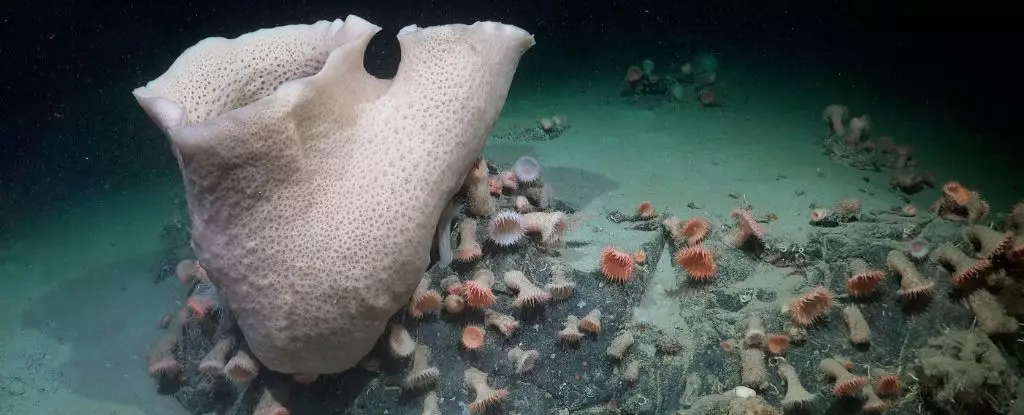Antarctica, often confined to our imaginations as the unfathomable icy desolation at the bottom of the world, has just revealed its double life as a veritable cradle of biodiversity. The recent calving of an iceberg the size of Chicago from the George VI Ice Shelf has not only disrupted the landscape but has also unmasked a plethora of hidden marine ecosystems. With the advance of human knowledge, this extraordinary phenomenon raises essential questions about our responsibilities regarding climate change and the preservation of such unique habitats. Here’s why this revelation is crucial for our understanding of life under ice.
A Rare Scientific Opportunity Unfolds
In early 2025, while the world grappled with turbulent socio-political issues, a group of researchers stationed in Antarctica saw their expedition plans change dramatically as an iceberg unexpectedly shed its icy layers. The excitement enveloping the scientific team as they maneuvered their remotely operated vehicle, SuBastian, into the newly exposed depths is palpable in comments from expedition co-chief scientist Patricia Esquete. The event exemplifies the often serendipitous nature of scientific research, where the unpredictable can lead to unprecedented discoveries.
While the initial focus was to study the seafloor and the ecosystems where ice meets ocean, the excitement of this coup de théâtre opened a door into a world never before touched by human eyes. This speaks volumes about the astonishing surprises nature has in store, challenging our hubris in thinking we know all there is to know about ecosystems that sit cloistered under thick ice for potentially centuries.
The Unseen Ecosystem Beneath the Ice
The findings were as breathtaking as they were humbling. Researchers uncovered a complex tapestry of life, including sponges, corals, and hydroids, which had thrived in complete isolation for decades, if not centuries. This ecosystem’s resilience compels us to rethink our understanding of life itself. Not only did it survive under extreme conditions devoid of sunlight, but it thrived on ocean currents, hinting at evolutionary strategies that we have yet to fully comprehend.
Esquete’s remark about the age of some species—potentially centuries old—evokes a certain reverence towards these underwater inhabitants. A singular sponge may show us the extensive timeline of marine life’s adaptability, challenging our environmentally casual attitudes towards climate change. Such ancient organisms bound in this uncharted territory wield stories of survival that could illuminate ecological strategies applicable across the globe.
Technological Challenges and Triumphs
The expedition shines a spotlight on the challenges researchers face in sub-ice exploration. Extreme temperatures, crushing pressures, and reliance on acoustic navigation highlight the complexities involved in uncovering the ocean’s depths beneath heavy ice. These difficulties emphasize the bravery and resourcefulness of scientists like Aleksandr Montelli, who revels in the interdisciplinary nature of their work as they usher scientific understanding into untraveled territories.
This technical triumph over obstacles adds a new lens through which we can view scientific research—one that celebrates human ingenuity and the collaboration of nations in pursuit of knowledge. The fact that researchers from various countries could come together to take full advantage of this unexpected event speaks to our collective potential when our common goals unite us.
Understanding Our Impact on Fragile Ecosystems
While the excitement of discovery prevails, we must approach these revelations cautiously. The findings in the Bellingshausen Sea raise critical alarm bells about the implications of ice loss for marine biodiversity. As climate change continues to reshape our planet, the repercussions extend far beyond the immediate loss of ice. This ecosystem may now serve as a harbinger of what is to come in other parts of the world.
The swift influx of new life in areas previously devoid of species underscores the ceaseless cycle of ecosystem evolution. However, it also stimulates a deeper conversation about our responsibilities as stewards of the Earth. Engaging with these ecosystems emphasizes the urgency of our actions—both personal and political—in halting climate change.
Embracing Urgency with Hope
Thus, the calving of the iceberg is more than a mere geological event; it’s a wake-up call. It compels us to engage actively in dialogue about our environmental impacts and reinforces the interconnectedness of global ecosystems. The beauty found beneath the ice serves as a poignant reminder that nature will adapt no matter our choices, but does it need to come at such a cost? The discourse surrounding these ecosystems must extend beyond academia; we, as global citizens, must advocate for their protection while cherishing the fragile wonders that lie beneath our changing world.


Leave a Reply